
Sayatva Frac Valves




Greaseless gate valve engineered specifically for FRAC applications.
Designed to operate reliably under extreme pressure and abrasive conditions.
UX100 eliminates the need for traditional lubrication.
Reduced maintenance requirements, enhanced service life.
Ensuring consistent performance in demanding hydraulic fracturing operations.




Reduce Operating Cost
Time Savings & Safer Operations


Reduced Maintenance
NACE MR0175
PSL 1, 2, 3 & 3G
2-1/6" to 7-1/6"
WP 10,000 to 20,000 PSI
Hydraulic or Electric Actuator
Temp Class L to X


API 6A PR2F Qualified
Sayatva Choke & Kill Manifold

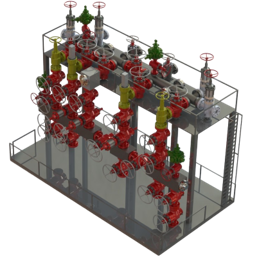
Sayatva choke and kill manifolds are designed to manage well pressure during drilling, testing, and emergency shut-in operations. Built for working pressures of 5,000, 10,000, and 15,000 psi, these manifolds are suitable for both land rigs and offshore rigs, including HPHT wells and sour service environments.
Key Features
API Compliance: Fully compliant with API 6A and API 16C, ensuring global standardization and reliability.
Modular Skid-Mounted Design: Pre-commissioned units with buffer chambers and drilling chokes for rapid deployment and integration.
Valve Configuration: Equipped with manual or hydraulic gate valves, hydraulic, manually adjustable or positive chokes, and pressure gauges for precise control.
Material & Performance Ratings:
Material Classes: AA to HH for corrosive and high-temperature conditions.
PSL Levels: PSL1 to PSL3G for varying traceability and testing rigor.
PR Levels: PR1 and PR2 for performance validation under extreme conditions.
Certifications: Third-party approvals including ABS CDS and DNV-GL-OS-E101, supporting offshore compliance and safety.

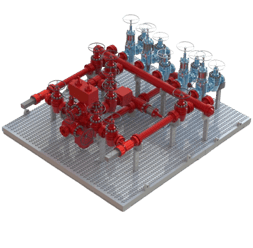
Offshore
Choke & Kill Manifold
Onshore
Choke & Kill Manifold
Sayatva Junk Catcher Manifold
Sayatva Junk Catcher Manifold is a high-pressure, modular unit designed for onshore and offshore well testing, flowback, and post-stimulation cleanup. Its primary function is to remove solid contaminants—such as drilling cuttings, formation debris, proppant, and scale—from the fluid stream before it reaches sensitive equipment like choke manifolds, pressure control valves, and measurement instruments.
This debris interception is critical during:
Well cleanup after drilling or workover
Flowback following stimulation or fracturing
Managed Pressure Drilling (MPD) operations
By isolating solids early in the flow path, the manifold:
Prevents erosion and clogging of downstream components
Reduces maintenance frequency and downtime
Improves safety by controlling pressure and debris discharge
Enables real-time monitoring and chemical injection via integrated ports
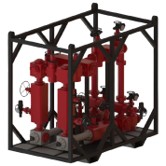

Modular, Skid Mounted
NACE MR0175
Temp Class L to X
API 6A PR2F Qualified
NACE MR0175

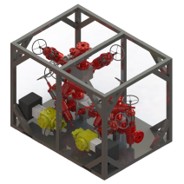
Sayatva Buffer Manifold serves as a critical component in MPD and well control systems, acting as a pressure dampener and flow stabilizer. It absorbs sudden volumetric surges in gas or fluid, helping to:
Protect downstream equipment from pressure spikes
Maintain consistent flow rates during transient operations
Enable safe routing and containment of wellbore fluids
This is especially vital during:
Flowback after stimulation
Pressure testing and cleanup
MPD operations with variable influx
Sayatva Buffer Manifold


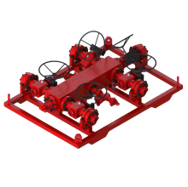

Standpipe Manifold
Cement Manifold
Standpipe Manifold — Purpose & Features
A standpipe manifold is a high-pressure mud routing system located on the rig floor. It connects the mud pumps to the standpipe, enabling fluid circulation through the drill string during drilling operations.
Key Functions:
Routes drilling mud from pumps to the top drive or kelly
Allows switching between pumps or flow paths
Provides pressure monitoring via standpipe gauges
Typical Features:
Pressure rating: Commonly 5,000 to 15,000 psi
Valve types: Gate valves with flanged or welded connections
Instrumentation: Standpipe pressure gauges and transducers
Configuration: Single or dual standpipe setups
Flexibility: Rotary and vibrator hoses for vibration isolation and alignment
Standpipe manifolds are essential for maintaining mud circulation, monitoring standpipe pressure, and ensuring safe fluid routing during drilling and well control operations.
Cement Manifold — Purpose & Features
A cement manifold is installed downstream of the cementing unit and is used to divert and control the flow of cement slurry during casing cementing operations. It ensures precise routing of fluids into the wellbore while maintaining pressure integrity and operational safety.
Key Functions:
Directs cement slurry from the pump to the casing or annulus
Allows switching between multiple flow paths
Enables pressure monitoring and isolation during cementing
Typical Features:
Pressure rating: Up to 20,000 psi
Connections: Hammer union or flanged
Instrumentation: Pressure and temperature indicators
Configuration: Free-standing or skid-mounted
Compliance: API 6A or API 16C depending on application
Cement manifolds are often customized to match rig layout and cementing program requirements, with multiple valves and ports for fluid control, sampling, and safety.
Sayatva manufactures API 20E-certified fasteners for demanding oil & gas applications, including valves, actuators, chokes, manifolds, and well testing equipment. These fasteners are marked with the API Monogram, ensuring compliance with globally accepted specifications and management systems.
Bolting Specification Levels
Available in BSL-1, BSL-2, and BSL-3, covering increasing levels of quality control and traceability.
Material Grades:
ASTM A193 B7 / B7M
ASTM A320 L7 / L7M
ASTM A193 B8 / A320 BBM
Nuts: A194 Gr 2H, Gr 4, Gr 7, B8, B8M
Temperature Range: From –75°F to 1100°F, suitable for both standard and NACE service conditions.
Traceability: EN10204 3.1 certification with mill certificates, heat and lot numbers, full test reports, and optional third-party inspection.
Coating Options
Xylan: Friction protection for high-pressure loads
Molybdenum Disulfide: Friction protection for high pressure loads
Phosphate: Ferrous metal coating for anti-galling and minor corrosion resistance
Zinc: Weathering and corrosion protection
Applications
Surface & subsea equipment per API 6A, 6D, 6DSS, 16A, 16C, and 17D
High-pressure manifolds and Managed Pressure Drilling (MPD) systems
Sayatva’s fasteners are built for reliability in harsh environments, with rigorous testing and documentation to meet the most demanding operational and safety standards.

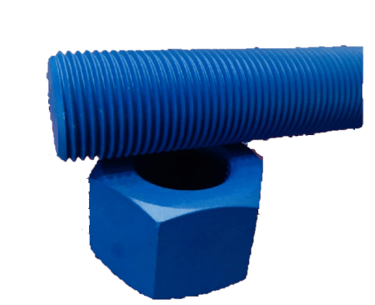

Contact Us Today
Have questions or need assistance? Our team is here to help! Reach out to us via phone, email, or our contact form. We look forward to hearing from you and providing the support you need.

